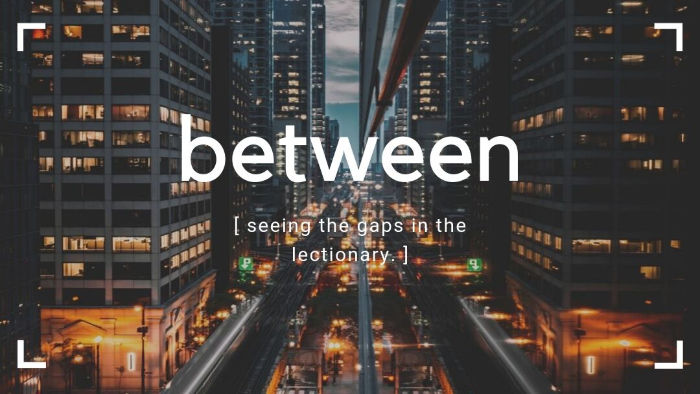A look at the gaps in the lectionary.
This week: the gap between Epiphany 1A and Epiphany 2A.
The text: John 1:24-28.
At the beginning of Year A of the Revised Common Lectionary (RCL), we’ve had a lot of John the Baptist. This, of course, is not surprising in the least. But what we do get is pretty much the whole story (more or less) in Matthew.
In the second and third weeks of Advent, we get the coming of John the Baptist and his later doubting of Jesus. Then in the Baptism scene, we get John’s seminal moment with the Christ.
While the lectionary doesn’t tell the story linearly, it is told. And as a preacher, I’m afforded the opportunity to brighten up the context.
This week, the lectionary gives us a kind of curveball. And not one of the kinds I like.
We change gospels from Matthew to John. And in so doing, we get a very different narrative arc for John, the disciples, and the nature of Jesus’s baptism.
Of course, I’m conscious of the lectionary’s intention. Especially how these moves can give us a chance to see these moments in a different way given a different context for ourselves.
But it is also a deeply disorienting move—to go from one contained narrative arc to a different one. And made all the more difficult for the preacher when the narrative arcs seem to blend together as these do.
Last week, we had the baptism, so this week we get John’s reaction to the baptism. So, in a sense, we might ask “What’s the problem?”
Again, there isn’t one. Just a concern. And one I hope those following at home notice.
These aren’t interchangeable stories.
The Synoptics (Mark, Matthew, and Luke) are telling the big stuff in similar ways. Jumping between them is not terribly hazardous. John, on the other hand, is doing completely different things. He marches to his own drummer.
And what this particular jump from Matthew to John does is it exposes the downside of the narrative we’re developing in church together: harmonizing.
One of the big things our brains do is respond to stimulus. They take in new information and process it. And like any efficient system, it does a preliminary scan to see if it knows what to do with that info.
Say you’re reading a book and you glance down at the page number: 27. You retrieve from the counting bucket “28” is next in line, from the book bucket “the next page is “28,” and from the math bucket “I have 7 more pages to get to my reading goal for the day.”
And one of our brains’ favorite things to do is to fill in gaps in information. In other words, we’re built to assume.
So when we read about John baptizing Jesus last week and then read about John’s response this week, our brains automatically assume this is a single story. Even when we know they come from different writers. The most natural response is to believe that this is what really happened next in the historical story.
To remind one another that these are different stories reflecting different narratives is to work against how our brains naturally process this information.
Now, don’t get me wrong, I live for those moments. I absolutely love that process of pushing against our assumptions to see the truth in a new light.
My concern is for what is automatic in this process. And what that means for followers of Jesus of any age. Even if we really buy into the episodic nature of our lectionary.
A better text for today
If the lectionary really wanted to lean into this jump toward John (they don’t, as we’re jumping back to Matthew next week), it would go to a passage that more naturally connects with what Matthew has been doing so far. The verses right before the lection.
In this one, we have a direct conflict with the priests and Levites. A bit of foreshadowing for what we will get throughout John’s narrative. And it folds really well into Matthew’s.
But what we do get is a different take on the baptism itself. And if we think about it, not unlike Matthew’s depiction of the birth story. It’s told as having happened.
Of course, what I’m likely to preach is John’s version of the call story. Which is in stark contrast with the Synoptics and the general understanding most of us have for the disciples. The dominant vision of the disciples is that the original four were fishermen. In John’s gospel, they are instead disciples of John the Baptist.
This difference gives John’s version a certain narrative push. Think about it. John the Baptist says someone better is coming and then the someone better shows up. Of course, those disciples will transition. It’s like they’re updating to the new operating system. And for those on a spiritual journey, it’s a compelling image. Jesus is a serious upgrade!
It also gives us two of our best nuggets of wisdom: Andrew as the true evangelist of the team. And then the naming of Peter. These are wonderful places to play in!
But there’s a reason tradition is way more interested in the disciples being fishermen. And not just for the corny joke about fishing for people. Fishermen are common. They don’t know their scripture. They’re probably not even literate. They are literally the everyperson in the story.
And like the holy family and those shepherds, they are the ones to whom the Incarnate One has come.
Then again, we’ll get that different story next week. When we jump back.
While preachers are likely to go in any number of ways on the text presented, I challenge you to do both things: take John’s narrative seriously and avoid harmonizing what “really happened”.
